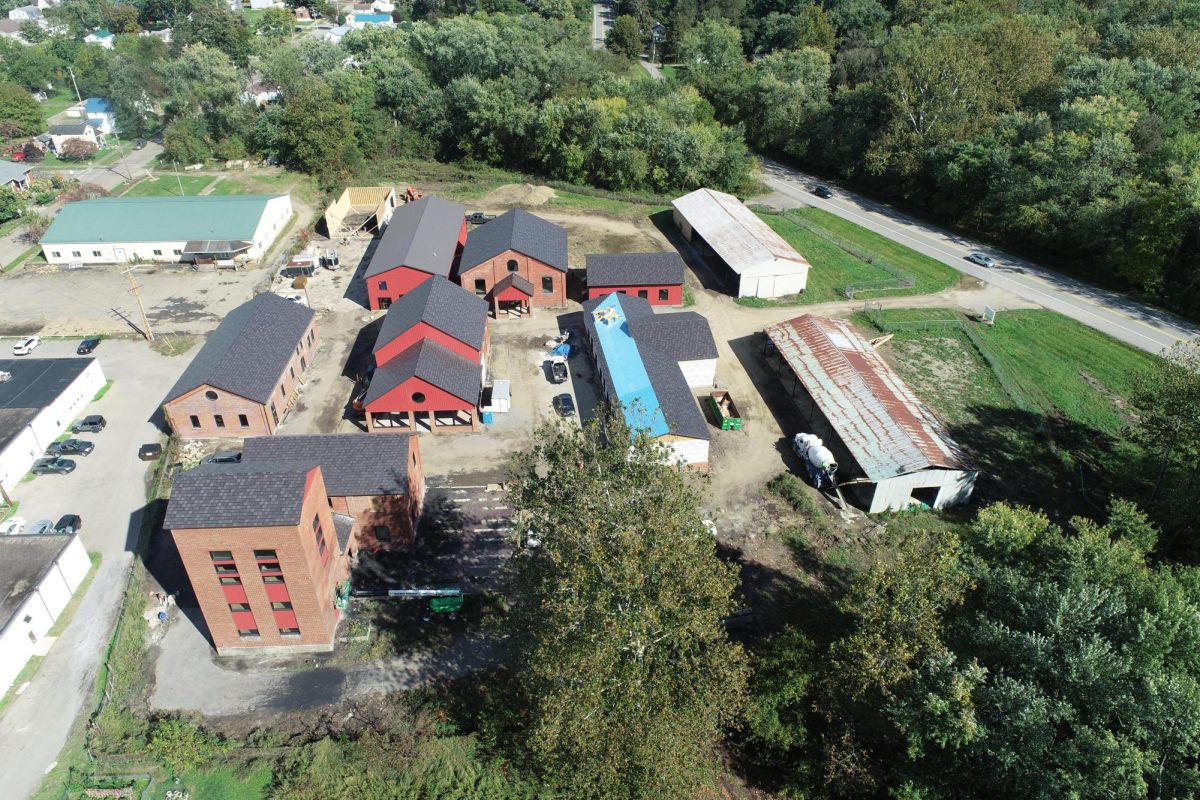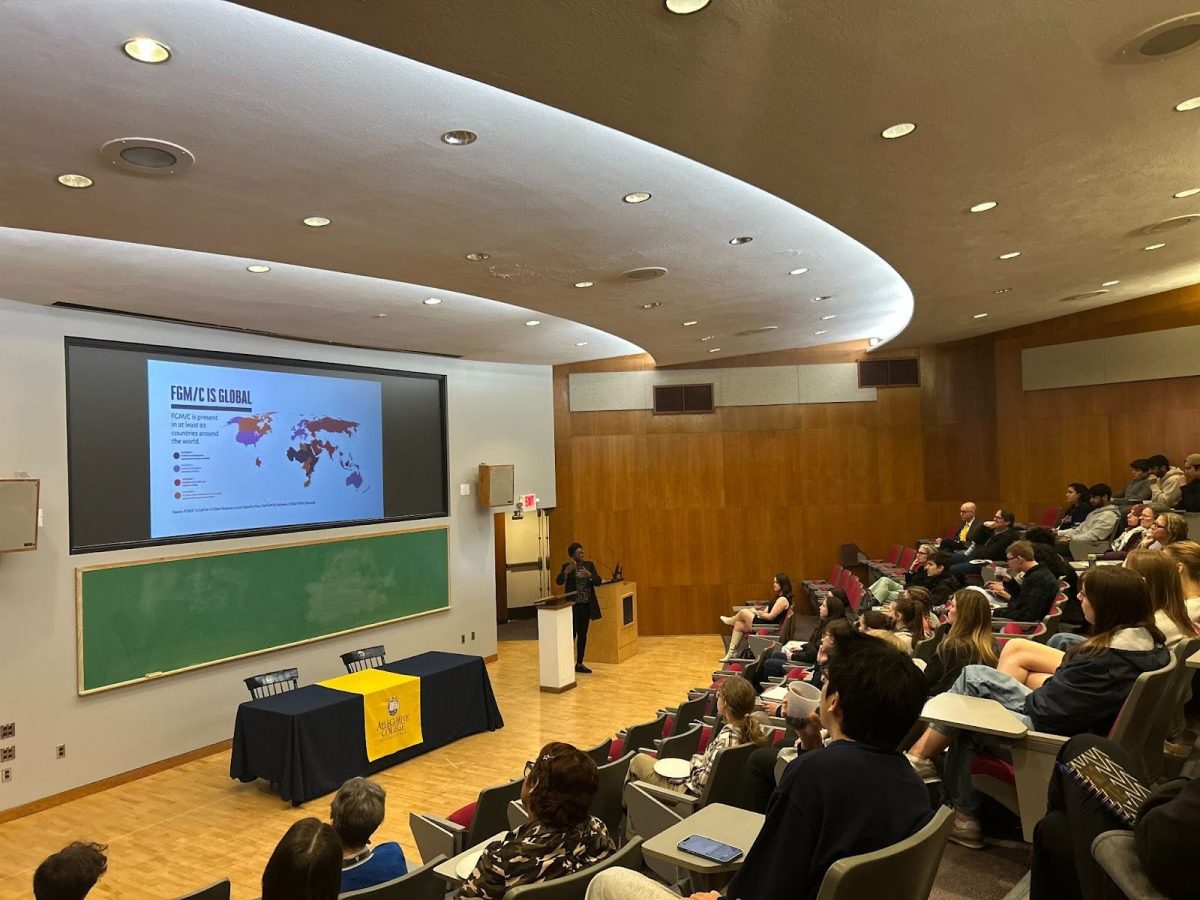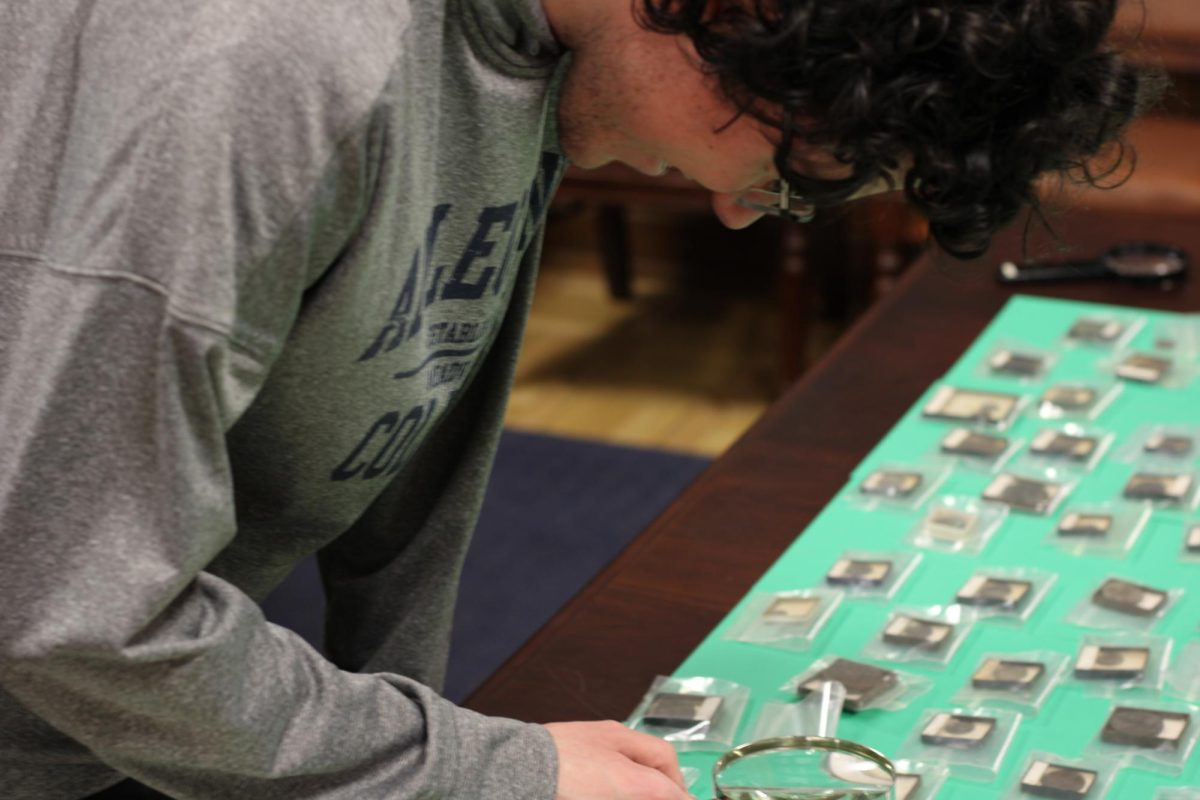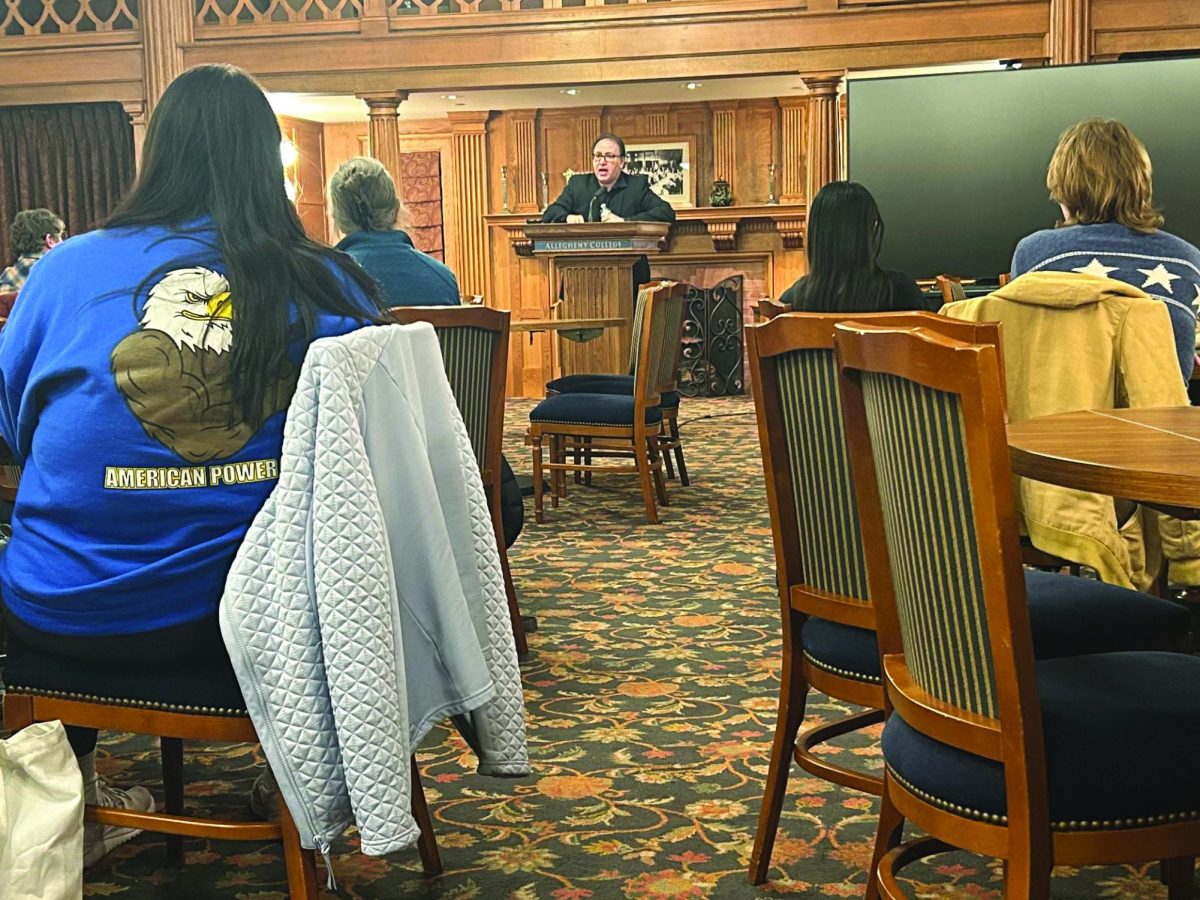For 30 years, former Acutec Precision Aerospace CEO Rob Smith watched as a set of abandoned buildings crumbled into the wetlands surrounding Spring Street and Race Street in Meadville’s Fifth Ward neighborhood. Now, thanks to a redevelopment vision shared by Smith, the Crawford County Historical Society, arts organizations, a variety of small businesses and Allegheny Environmental Science & Sustainability students, the property is on track to reclaim its former hustle and bustle as soon as June 2025. Once the construction dust settles, the former industrial park will house an all-season cultural hub called Cussewago Square.
Smith, who has supplied both funding and leadership for the project, has high hopes that Cussewago Square’s amenities will put Meadville on the map as a hotspot for local food, art and outdoor recreation.
“It could turn this place into a destination place for Meadville, and for the area — actually for northwest PA,” Smith said.
Smith described the concept as emerging organically from conversations with the Crawford County Historical Society, which held similar redevelopment aspirations when it purchased the 6.64-acre property back in 2022.
“The Meadville Community Theatre was talking with the Historical Society about this one building — ‘Maybe we could turn this into a theater? Is there any way we could use this?’ — And the Historical Society, of course, has no money,” Smith said.
After hearing about the organizations’ initial idea for a new theater, Smith and his wife, Nancy, leveraged the power of their real estate investment company, RAN Investments LLC, to make these dreams a reality. The Historical Society sold them the property in 2023, and Smith eagerly began laying out plans.
“We had some lovely old brick buildings that when they’re restored would just be beautiful,” Smith said. “So I talked to the theater people, and French Creek Community Theatre and Meadville Community Theatre both joined together to work on it. We jointly came up with some ideas for buildings where the theaters would be. And then I started looking at some of the other ones.”
From there, the project snowballed. At every turn, Smith found another structure full of possibilities — and a local organization ready to step inside.
One building with a distinctive tower caught his eye as the perfect home for a sweet treat, so he reached out to the owners of Cup n’ Spoon with an invitation to set up shop. Their response was unequivocal.
“We talked with them and they would love to turn that into another Cup n’ Spoon,” Smith said.
For those with an appetite for more savory fare, diners need not worry they will be left behind.
“We’re going to have an Italian restaurant called Dominico in one of the old metal buildings that were redone,” Smith said. “It’ll be a high-end restaurant. First one in Meadville in years.”
The French Creek Arts Collective will offer a space to peruse and pursue creativity.
“You’ll have a place to see some really good art,” Smith said. “We’ll have visiting artists there, artist workshops, classes, things of that sort.”
Cussewago Square’s outdoor spaces are just as thoughtfully designed. Around the square, open-access patios and an amphitheater will provide open-air venues for visitors to enjoy live music and scenic wetlands.
Smith has already mapped out how cyclists might use the neighboring Ernst Trail to travel as far as Conneaut Lake.
“In the summertime, there would just be all kinds of activities outside around the square,” Smith said. “You could bike in, park your bike, walk around, grab a coffee or a water, have lunch. There’s an old rail bridge that we were already working on getting state money to get fixed up. And you would eventually be able to tie (together) all of the bike trails and walking trails.”
To support this forecasted influx of ecotourism and local gastronomy, students in the Allegheny College Environmental Science and Sustainability Department have teamed up through a junior seminar led by professor Rich Bowden. Their semester-long research projects will culminate in detailed final proposals for sustainability interventions located throughout the square.
“I’ve known Rich Bowden for a long time and he knew what was going on,” Smith said. “And then he asked if, you know, could his class get involved? I said, ‘Sure.’”
Five groups have worked in parallel since late August, each assembling a different plan.
“We started with this big brainstorming session of stuff that we could do with the jurisdiction that we were given for the outside of the square,” said Katherine Cousineau, ’26. “We came up with a bunch of ideas and then kind of broke them up into categories and then those became the teams.”
Cousineau has worked alongside Riley Pegher, ’26, to design a pavilion outfitted with bike racks and other resources geared toward cyclists. This space may help reduce traffic congestion by welcoming alternative transportation methods to and from the square.
Lorenzo Tovanche, ’26, and Iris Styers, ’26, have planned an edible garden bed after interviewing Cup n’ Spoon owner Melissa Diedricks to assess the agricultural needs of Meadville restaurateurs.
“We want to make sure that the stuff we’re actually growing will be beneficial for her,” Tovanche said. “It’s just going to be like a supplement to what she is already getting from other vendors and stuff, and hopefully might help her cut costs somewhere in the future.”
Styers, whose academic concentration is in agriculture, has felt especially enthusiastic about an onsite plot for blackberries, raspberries, fruit trees and herbs.
“Since it’s right behind Cup n’ Spoon, it’s pretty easy farm-to-table,” Styers said. “I was really excited that there was an aspect that I could really dig into, because I feel like not a lot of people on this campus are more agriculture-focused, so there aren’t that many classes that offer it.”
Styers hopes that more visible small-scale agriculture will make the community feel more connected to their food systems.
“There isn’t really anything really agricultural-focused within actual downtown Meadville,” Styers said. “Obviously if you go like 10 minutes out in any direction there’s going to be farms there, but there’s nothing in the actual city per se.”
Tovanche finds motivation by envisioning how the people might interact within the public spaces he will have helped produce.
“That area is situated within — or at least really close to — Fifth Ward, which has obviously historically been a really disinvested community,” Tovanche said. “Speaking with the people that are in that community, it really seems like they feel an actual community again, like an actual neighborhood where people look out for each other.”
Prioritizing the property’s long-term environmental viability has been another important consideration that students like Macy Simons, ’26, have stepped up to address. She plans to conduct a senior comprehensive project next year assessing public policy about flooding and has used this class as an opportunity to become even more familiar with flood mitigation tactics.
“Part of the property borders the creek,” Simons said. “It is also — just based on the topography — it is in the floodplain. So it’s naturally more low-lying.”
Simons’ group reviewed a series of common mitigation tools, such as permeable pavement, rain barrels and land management practices, before identifying rain gardens as the most effective option for Cussewago Square.
“We’ve talked to Rob, we’ve talked to the landscapers and we’ve been on the site a lot trying to figure out where the best place is to put them,” Simons said.
These gardens will be beautiful and functional, Simons explained.
“Ernst Seeds, which is a local Meadville company, does have rain garden-specific seed blends,” Simons said. “So we’re leaning towards that. It’s a lot of native, very flood-tolerant plants that can sustain a lot of water.”
In contrast to underground stormwater systems, their rain gardens will allow water to safely reenter the wetland.
“There’s a pretty decent soil, substrate layer, that is designed to collect a lot of water and allow it to recharge into the groundwater system,” Simons said. “And it can also connect to a flood drain. So it’s a better alternative than having water just go from an impervious surface into the runoff like in the flood drain.”
Many of the buildings on the property date back to the late 1800s, when the area housed a distillery. Their historic significance has placed additional urgency on guaranteeing that these structures will be protected from flood damage — an endeavor that has rewarded historians with enticing clues into Meadville’s architectural past.
“It turns out that back in the 1870s, they built all these old buildings above the floodplain,” Smith said. “If you ever go over there to the square, you realize it’s actually elevated above the rest of Fifth Ward. The foundations of the buildings are 1,080.2 feet, I have it exactly, did laser (land surveying) and all that. And the floodplain is 1,080.2 feet.”
Smith predicts that in May 2026, droves of Allegheny students will choose to celebrate their graduation with an evening in Cussewago Square — something Bowden’s junior seminar class has already begun looking forward to.
“We should all make great reservations at the Italian restaurant for our families after graduation,” Cousineau joked.
For these students, a dinner in Cussewago Square will be more than symbolic of their academic achievements: they will be able to point out physical signs that their actions are part of a wider effort to support healthy, meaningful lives for people and ecosystems.
Tovanche categorizes the square as a “third place” — a term for shared spaces that connect people who might not otherwise cross paths.
“There’s work, there’s home,” Tovanche said. “But I hope and I anticipate that at least that could be a location for people to just congregate together outside of any responsibilities that they have. To just, you know, enjoy their time together as a community.”









